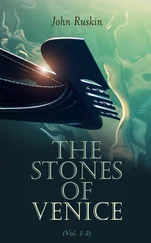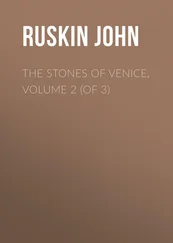John Ruskin - Stones of Venice [introductions]
Здесь есть возможность читать онлайн «John Ruskin - Stones of Venice [introductions]» — ознакомительный отрывок электронной книги совершенно бесплатно, а после прочтения отрывка купить полную версию. В некоторых случаях можно слушать аудио, скачать через торрент в формате fb2 и присутствует краткое содержание. Жанр: foreign_antique, foreign_home, literature_19, visual_arts, на английском языке. Описание произведения, (предисловие) а так же отзывы посетителей доступны на портале библиотеки ЛибКат.
- Название:Stones of Venice [introductions]
- Автор:
- Жанр:
- Год:неизвестен
- ISBN:нет данных
- Рейтинг книги:3 / 5. Голосов: 1
-
Избранное:Добавить в избранное
- Отзывы:
-
Ваша оценка:
- 60
- 1
- 2
- 3
- 4
- 5
Stones of Venice [introductions]: краткое содержание, описание и аннотация
Предлагаем к чтению аннотацию, описание, краткое содержание или предисловие (зависит от того, что написал сам автор книги «Stones of Venice [introductions]»). Если вы не нашли необходимую информацию о книге — напишите в комментариях, мы постараемся отыскать её.
Stones of Venice [introductions] — читать онлайн ознакомительный отрывок
Ниже представлен текст книги, разбитый по страницам. Система сохранения места последней прочитанной страницы, позволяет с удобством читать онлайн бесплатно книгу «Stones of Venice [introductions]», без необходимости каждый раз заново искать на чём Вы остановились. Поставьте закладку, и сможете в любой момент перейти на страницу, на которой закончили чтение.
Интервал:
Закладка:
SECTION XIV. The vital religion, observe, not the formal. Outward observance was as strict as ever; and doge and senator still were painted, in almost every important instance, kneeling before the Madonna or St. Mark; a confession of faith made universal by the pure gold of the Venetian sequin. But observe the great picture of Titian's in the ducal palace, of the Doge Antonio Grimani kneeling before Faith: there is a curious lesson in it. The figure of Faith is a coarse portrait of one of Titian's least graceful female models: Faith had become carnal. The eye is first caught by the flash of the Doge's armor. The heart of Venice was in her wars, not in her worship.
The mind of Tintoret, incomparably more deep and serious than that of Titian, casts the solemnity of its own tone over the sacred subjects which it approaches, and sometimes forgets itself into devotion; but the principle of treatment is altogether the same as Titian's: absolute subordination of the religious subject to purposes of decoration or portraiture.
The evidence might be accumulated a thousandfold from the works of Veronese, and of every succeeding painter,—that the fifteenth century had taken away the religious heart of Venice.
SECTION XV. Such is the evidence of Painting. To collect that of Architecture will be our task through many a page to come; but I must here give a general idea of its heads.
Philippe de Commynes, writing of his entry into Venice in 1495, says,—
"Chascun me feit seoir au meillieu de ces deux ambassadeurs qui est l'honneur d'Italie que d'estre au meillieu; et me menerent au long de la grant rue, qu'ilz appellent le Canal Grant, et est bien large. Les gallees y passent à travers et y ay veu navire de quatre cens tonneaux ou plus pres des maisons: et est la plus belle rue que je croy qui soit en tout le monde, et la mieulx maisonnee, et va le long de la ville. Les maisons sont fort grandes et haultes, et de bonne pierre, et les anciennes toutes painctes; les aul tres faictes depuis cent ans: toutes ont le devant de marbre blanc, qui leur vient d'Istrie, à cent mils de la, et encores maincte grant piece de porphire et de sarpentine sur le devant…. C'est la plus triumphante cité que j'aye jamais veue et qui plus faict d'honneur à ambassadeurs et estrangiers, et qui plus saigement se gouverne, et où le service de Dieu est le plus sollennellement faict: et encores qu'il y peust bien avoir d'aultres faultes, si croy je que Dieu les a en ayde pour la reverence qu'ilz portent au service de l'Eglise." [Footnote: Mémoires de Commynes, liv. vii. ch. xviii.]
SECTION XVI. This passage is of peculiar interest, for two reasons. Observe, first, the impression of Commynes respecting the religion of Venice: of which, as I have above said, the forms still remained with some glimmering of life in them, and were the evidence of what the real life had been in former times. But observe, secondly, the impression instantly made on Commynes' mind by the distinction between the elder palaces and those built "within this last hundred years; which all have their fronts of white marble brought from Istria, a hundred miles away, and besides, many a large piece of porphyry and serpentine upon their fronts."
On the opposite page I have given two of the ornaments of the palaces which so struck the French ambassador. [Footnote: Appendix 6, "Renaissance Ornaments."] He was right in his notice of the distinction. There had indeed come a change over Venetian architecture in the fifteenth century; and a change of some importance to us moderns: we English owe to it our St. Paul's Cathedral, and Europe in general owes to it the utter degradation or destruction of her schools of architecture, never since revived. But that the reader may understand this, it is necessary that he should have some general idea of the connection of the architecture of Venice with that of the rest of Europe, from its origin forwards.
SECTION XVII. All European architecture, bad and good, old and new, is derived from Greece through Rome, and colored and perfected from the East. The history of architecture is nothing but the tracing of the various modes and directions of this derivation. Understand this, once for all: if you hold fast this great connecting clue, you may string all the types of successive architectural invention upon it like so many beads. The Doric and the Corinthian orders are the roots, the one of all Romanesque, massy-capitaled buildings—Norman, Lombard, Byzantine, and what else you can name of the kind; and the Corinthian of all Gothic, Early English, French, German, and Tuscan. Now observe: those old Greeks gave the shaft; Rome gave the arch; the Arabs pointed and foliated the arch. The shaft and arch, the frame-work and strength of architecture, are from the race of Japheth: the spirituality and sanctity of it from Ismael, Abraham, and Shem.
SECTION XVIII. There is high probability that the Greek received his shaft system from Egypt; but I do not care to keep this earlier derivation in the mind of the reader. It is only necessary that he should be able to refer to a fixed point of origin, when the form of the shaft was first perfected. But it may be incidently observed, that if the Greeks did indeed receive their Doric from Egypt, then the three families of the earth have each contributed their part to its noblest architecture: and Ham, the servant of the others, furnishes the sustaining or bearing member, the shaft; Japheth the arch; Shem the spiritualization of both.
SECTION XIX. I have said that the two orders, Doric and Corinthian, are the roots of all European architecture. You have, perhaps, heard of five orders; but there are only two real orders, and there never can be any more until doomsday. On one of these orders the ornament is convex: those are Doric, Norman, and what else you recollect of the kind. On the other the ornament is concave: those are Corinthian, Early English, Decorated, and what else you recollect of that kind. The transitional form, in which the ornamental line is straight, is the centre or root of both. All other orders are varieties of those, or phantasms and grotesques altogether indefinite in number and species. [Footnote: Appendix 7, "Varieties of the Orders."]
SECTION XX. This Greek architecture, then, with its two orders, was clumsily copied and varied by the Romans with no particular result, until they begun to bring the arch into extensive practical service; except only that the Doric capital was spoiled in endeavors to mend it, and the Corinthian much varied and enriched with fanciful, and often very beautiful imagery. And in this state of things came Christianity: seized upon the arch as her own; decorated it, and delighted in it; invented a new Doric capital to replace the spoiled Roman one: and all over the Roman empire set to work, with such materials as were nearest at hand, to express and adorn herself as best she could. This Roman Christian architecture is the exact expression of the Christianity of the time, very fervid and beautiful—but very imperfect; in many respects ignorant, and yet radiant with a strong, childlike light of imagination, which flames up under Constantine, illumines all the shores of the Bosphorus and the Aegean and the Adriatic Sea, and then gradually, as the people give themselves up to idolatry, becomes Corpse-light. The architecture sinks into a settled form—a strange, gilded, and embalmed repose: it, with the religion it expressed; and so would have remained for ever,—so does remain, where its languor has been undisturbed. [Footnote: The reader will find the weak points of Byzantine architecture shrewdly seized, and exquisitely sketched, in the opening chapter of the most delightful book of travels I ever opened,– Curzon's "Monasteries of the Levant."] But rough wakening was ordained.
Читать дальшеИнтервал:
Закладка:
Похожие книги на «Stones of Venice [introductions]»
Представляем Вашему вниманию похожие книги на «Stones of Venice [introductions]» списком для выбора. Мы отобрали схожую по названию и смыслу литературу в надежде предоставить читателям больше вариантов отыскать новые, интересные, ещё непрочитанные произведения.
Обсуждение, отзывы о книге «Stones of Venice [introductions]» и просто собственные мнения читателей. Оставьте ваши комментарии, напишите, что Вы думаете о произведении, его смысле или главных героях. Укажите что конкретно понравилось, а что нет, и почему Вы так считаете.
![John Ruskin Stones of Venice [introductions] обложка книги](/books/732383/john-ruskin-stones-of-venice-introductions-cover.webp)











